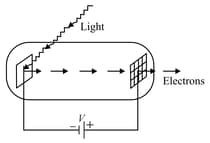Embibe Experts Solutions for Chapter: Dual Nature of Matter and Radiation, Exercise 1: JEE Advanced Paper 1 - 2015
Embibe Experts Physics Solutions for Exercise - Embibe Experts Solutions for Chapter: Dual Nature of Matter and Radiation, Exercise 1: JEE Advanced Paper 1 - 2015
Attempt the free practice questions on Chapter 20: Dual Nature of Matter and Radiation, Exercise 1: JEE Advanced Paper 1 - 2015 with hints and solutions to strengthen your understanding. EMBIBE CHAPTER WISE PREVIOUS YEAR PAPERS FOR PHYSICS solutions are prepared by Experienced Embibe Experts.
Questions from Embibe Experts Solutions for Chapter: Dual Nature of Matter and Radiation, Exercise 1: JEE Advanced Paper 1 - 2015 with Hints & Solutions
In a photoemission experiment, the maximum kinetic energies of photoelectrons from metals and are and , respectively, and they are related by . In this experiment, the same source of monochromatic light is used for metals and while a different source of monochromatic light is used for the metal . The work functions for metals and are and , respectively. The energy of the incident photon used for metal , in is ___.
In a photoelectric experiment, a parallel beam of monochromatic light with the power of is incident on a perfectly absorbing cathode of work function . The frequency of light is just above the threshold frequency so that the photoelectrons are emitted with negligible kinetic energy. Assume that the photoelectron emission efficiency is 100%. A potential difference of is applied between the cathode and the anode. All the emitted electrons are incident normally on the anode and are absorbed. The anode experiences a force due to the impact of the electrons. The value of is __________. Mass of the electron .
A photoelectric material having work-function is illuminated with a light of wavelength . The fastest photoelectron has a de Broglie wavelength . A change in wavelength of the incident light by results in a change in . The ratio is proportional to
Light of wavelength falls on a cathode plate inside a vacuum tube as shown in the figure. The work function of the cathode surface is and the anode is a wire mesh of conducting material kept at a distance from the cathode. A potential difference is maintained between the electrodes. If the minimum de Broglie wavelength of the electrons passing through the anode is which of the following statement(s) is(are) true ?

A metal surface is illuminated by light of two different wavelengths 248 nm and 310 nm. The maximum speeds of the photoelectrons corresponding to these wavelengths are u1 and u2, respectively. If the ratio and , the work function of the metal is nearly
In a historical experiment to determine Planck's constant, a metal surface was irradiated with light of different wavelengths. The emitted photoelectron energies were measured by applying a stopping potential. The relevant data for the wavelength of incident light and the corresponding stopping potential are given below:
| 0.3 | 2.0 |
| 0.4 | 1.0 |
| 0.5 | 0.4 |
Given that Planck's constant (in units of ) found from such an experiment is :
For photo-electric effect with incident photon wavelength , the stopping potential is . Identify the correct variation(s) of with and .
A pulse of light of duration is absorbed completely by a small object initially at rest. Power of the pulse is and the speed of light is . The final momentum of the object is
